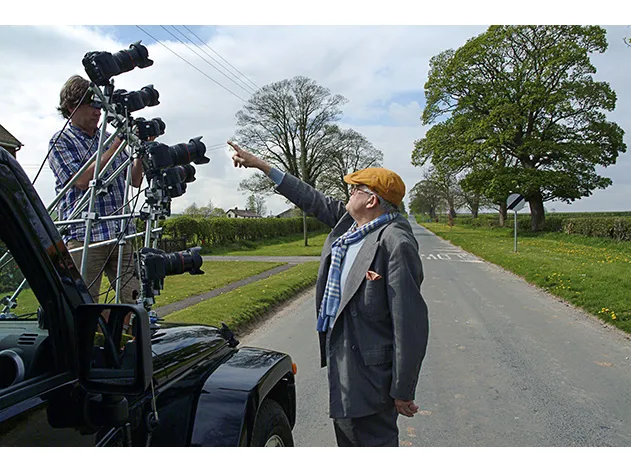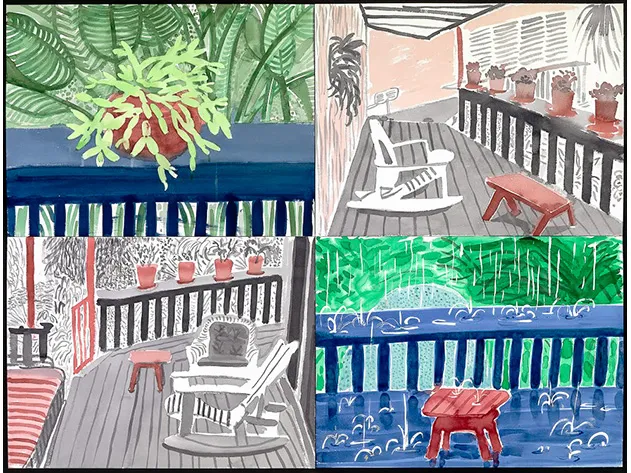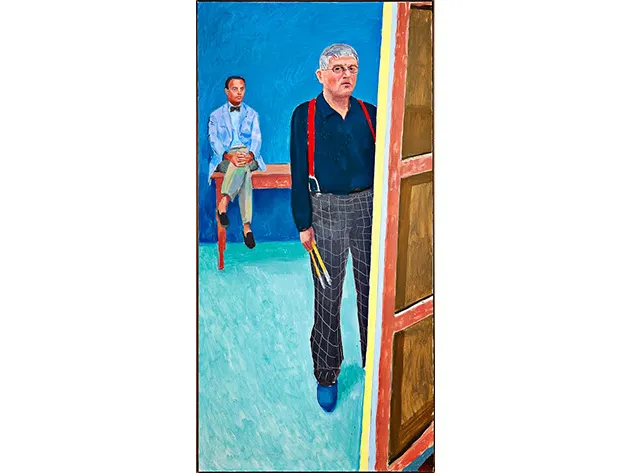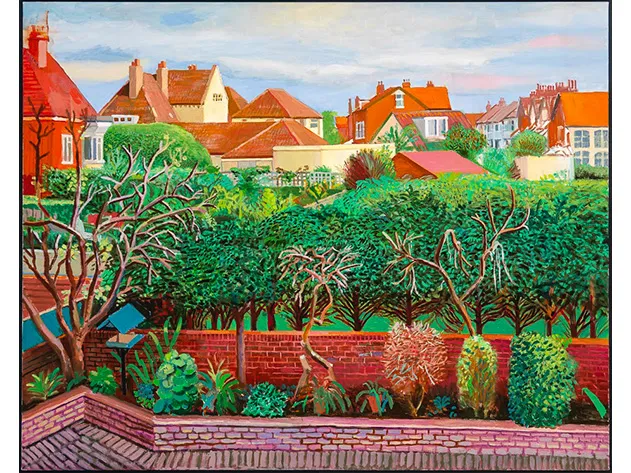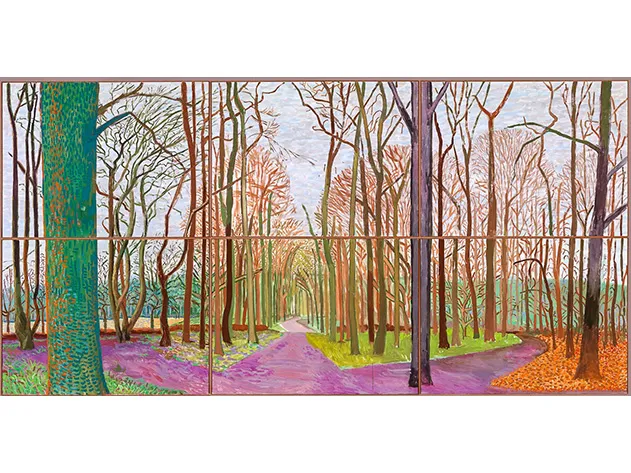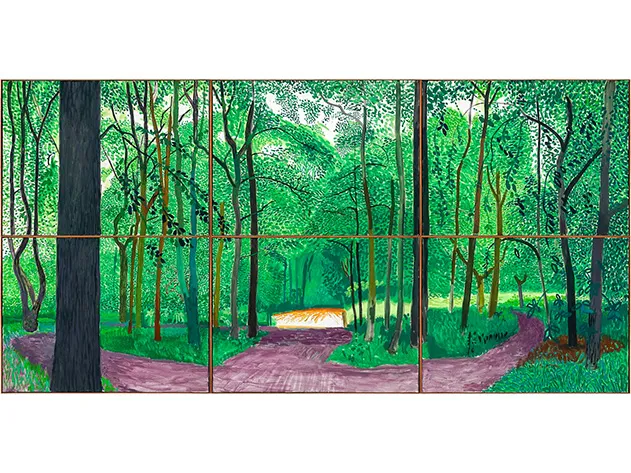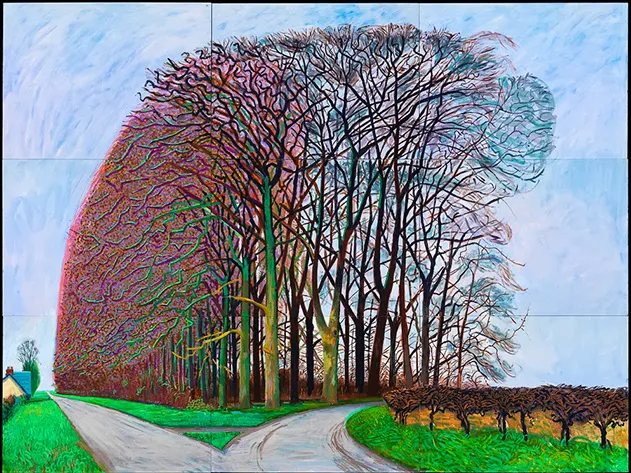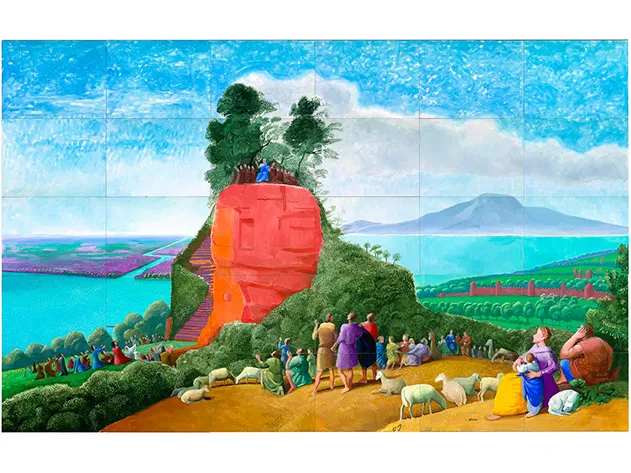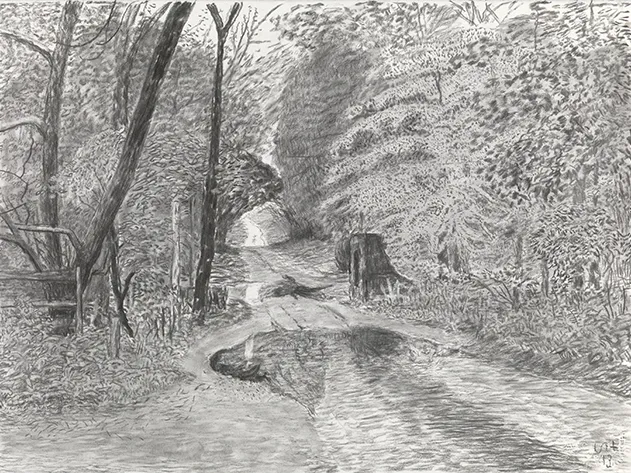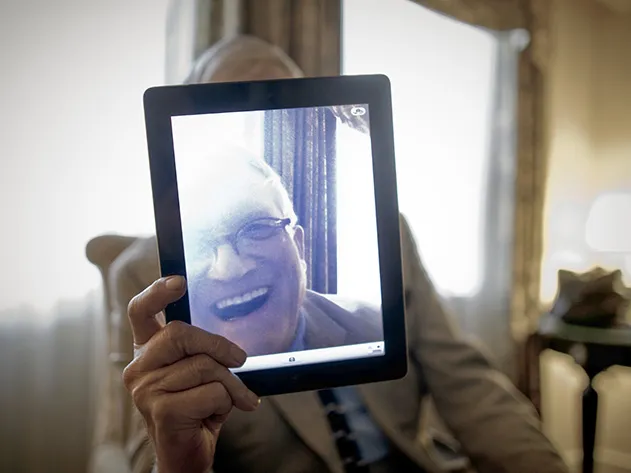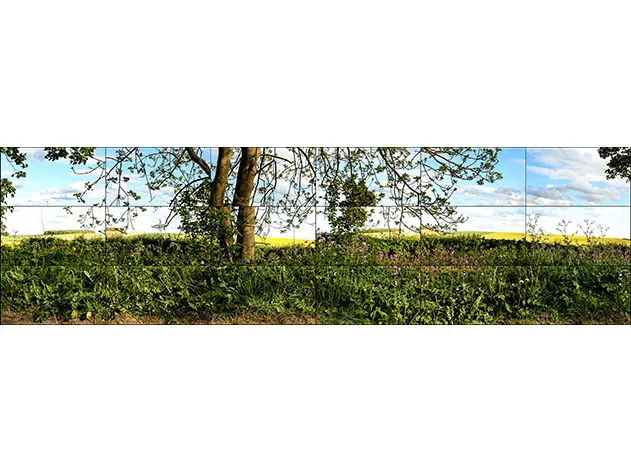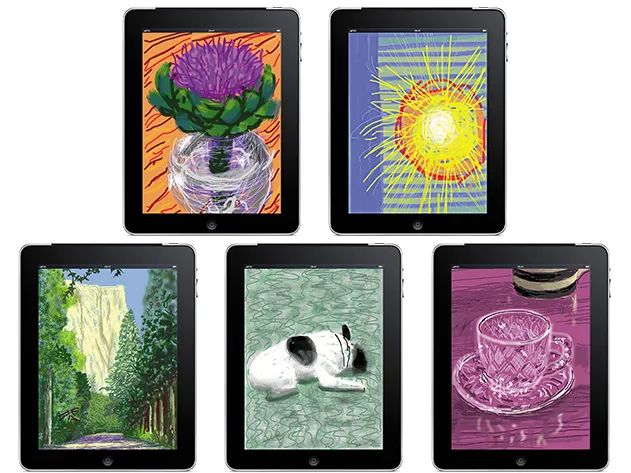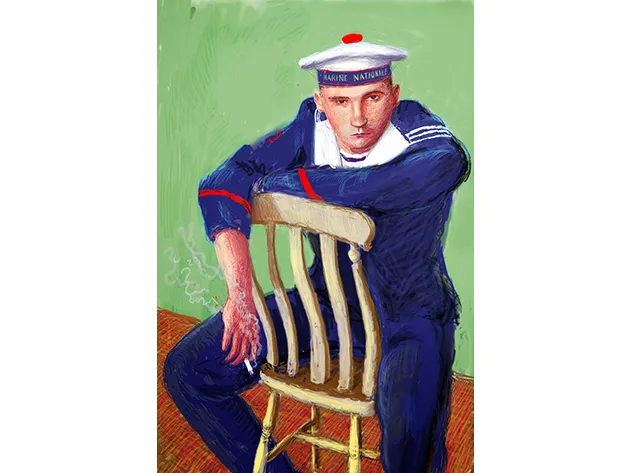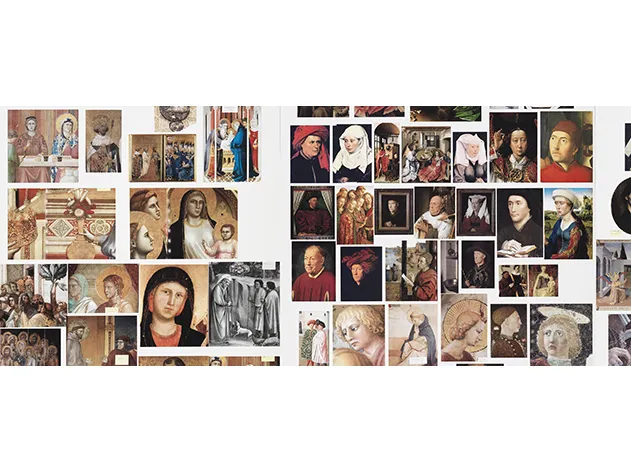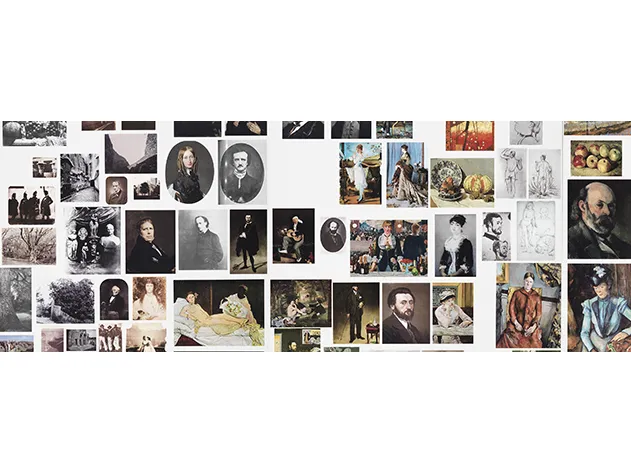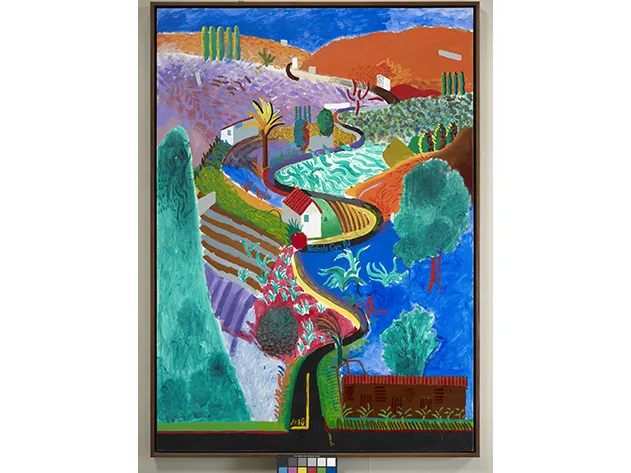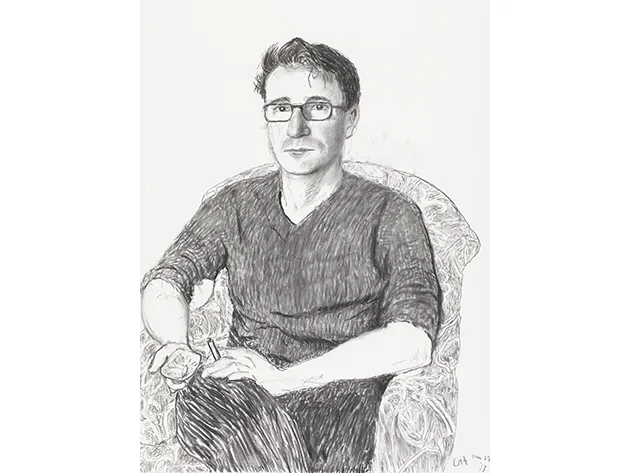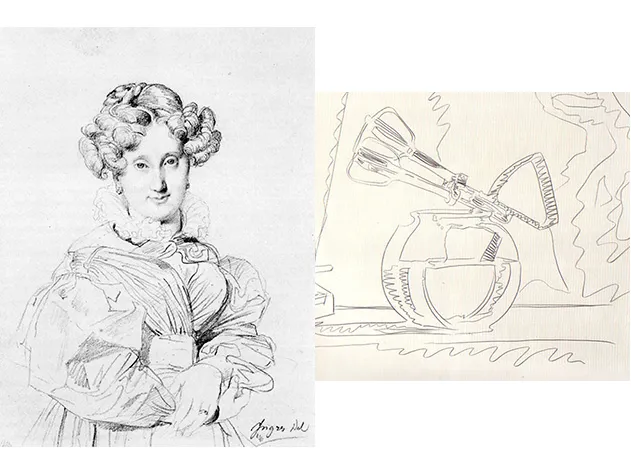Why David Hockney Has a Love-Hate Relationship With Technology
A new retrospective highlights the artist’s two, seemingly opposite passions
/https://tf-cmsv2-smithsonianmag-media.s3.amazonaws.com/filer/Davick-Hockney-631.jpg)
David Hockney is often given to proclaiming, "if you don't mind looking at the world from the point of view of a paralyzed Cyclops—for a split second. But that's not what it's like to live in the world." At which point he's likely to unfurl the example of a 5-year-old who when told to draw a picture of his house will probably include the front porch, the backyard, the doghouse in the backyard, the driveway off to one side, the trees off to the other, the window overlooking the far back corner—everything he knows is there, all on one plane of viewing—until Teacher comes along and says, No, he's done it wrong, that you couldn't possibly see all that from one place, thereby enforcing an entirely arbitrary one-point perspective. "And yet the kid had it right in the first place," Hockney will insist. "He was showing you everything that made up his home, just like you'd asked."
Hockney is that kid—still is, at age 76, seemingly having lost none of the prodigious verve that characterized him when he first exploded onto the London art scene as a boy wonder back in the early '60s. And central to that persistent youthfulness has been an uncanny openness to technological innovation, the eager willingness to delve into any and all manner of new gadgetry—fax machines, color photocopiers, car stereo CD systems, LED stage lighting grids, iPhones, iPads, HD videocameras—often long before anyone else even sees their artistic potential as part of what is, to hear him tell it, an ages-old human pursuit, going all the way back to Paleolithic cave painters: the simple urge to render a convincing figurative approximation of the world.
The two aspects of Hockney's passion—the adamantly hand-rendered and the wildly technologically amplified—will both be on vivid display at a major retrospective of his work since the beginning of the new century, opening in late October (through January 20, 2014) at the de Young Museum in San Francisco: a survey, that is, of pretty much everything he's been up to since the Great Wall.
***
The Great Wall In 1999, while visiting an Ingres retrospective at the National Gallery in London and closely examining several of the great French master's extraordinarily accomplished early pencil drawings of English aristocrats (from around 1815), Hockney became convinced that he'd seen that sort of seemingly effortless, confidently assured line before, but where?—Oh wait, that was it, in Andy Warhol's drawings of common household utensils, of all places! Now, Warhol's assurance arose from the fact that he was tracing off slide-projected photographs, but how could Ingres have been doing it? In the first of a dazzling series of leapfrogging insights, Hockney came to believe that Ingres must have been using a then-only-recently invented camera lucida, a tiny prism held horizontally steady at the end of a stick more or less at eye level above the flat sketching surface, looking down through which the artist could see the, as it were, periscoped image of the subject sitting in front of him, seemingly overlaid atop the empty sketching surface below. The artist could then block in the location of key features (the pupils of the eyes, say, and the corners of the lips and nostrils, the lie of the ears and the line of the hair, the flow of the enveloping garments), greatly facilitating the drafting process.
In the months that followed, Hockney started noticing evidence of the same "look" in the work of artists long before Ingres, past Vermeer, and all the way back to Caravaggio. Indeed, Hockney now became convinced that Caravaggio must have been employing some similar sort of optical aid, in his case more likely some kind of pinhole in a wall, perhaps amplified by a simple focusing lens, which is to say a primitive camera obscura.
At the studio above his Hollywood Hills home, Hockney cleared the long far wall (which runs the length of the tennis court over which the studio had been built and stands two stories high) and began covering it with photocopied color images from the history of Western art, drawing on his formidable personal library of such books, shingling the copies all across the wall in chronological order—1350 to one side, 1900 to the other, Northern Europe above and Southern Europe below. Surveying the resultant Great Wall, as he and his assistants now took to calling it, Hockney set to wondering, Where and when had that optical look made its first appearance? With the suspects arrayed before him like that, the answer soon became obvious: roughly five years to either side of 1425, first apparently in Bruges with Van Eyck and his followers, and then hard on in Florence with Brunelleschi and his, it was as if Europe had simply put on its spectacles. All at once, a type of depiction that had previously seemed halting and awkward suddenly became vivid and exact—and in the same, particular way.
But how, Hockney now wondered, could Van Eyck possibly have accomplished such a remarkable leap, since there was no evidence that lenses had yet come into existence? The next breakthrough came when Charles Falco, a visiting physicist from the University of Arizona who specializes in quantum optics, informed Hockney of something known to any first-year physics student, though apparently unknown to almost every art historian: the fact that concave mirrors (the flip sides, that is, of the convex mirrors that suddenly start appearing all over the place in Flemish paintings around 1430) are capable of projecting images of outside reality onto a darkened flat surface, images that can be traced, in exactly the same way as with a focusing lens. Reviewing the images arrayed along the Great Wall, the two striding side by side, like intent generals inspecting their troops, Falco suddenly singled out one in particular—the Lorenzo Lotto Husband and Wife of 1543, which features a Persian carpet table covering in the foreground that seems to go in and out of focus at particular intervals. Subjecting the image to further analysis, Falco was presently able to construct a mathematical proof showing that Lotto would have had to have used some sort of optical device.
Hockney's and Falco's discoveries and speculations were decidedly controversial. Conventional art historians seemed to take particular umbrage. Where, they demanded, was the hard evidence, the testimonies or manuals or letters or sketches? As it happened, Hockney's studio assistants David Graves and Richard Schmidt were able to dig up a good deal of such contemporary evidence, which Hockney included in 2001 as appendices in a sumptuously illustrated, carefully argued volume laying out the whole theory, Secret Knowledge: Rediscovering the Lost Techniques of the Old Masters.
More generally, people seemed offended that Hockney was suggesting that the old masters had somehow cheated. Hockney countered that he wasn't suggesting anything of the sort—that he was speaking of a time, at least at the outset, when the gap between the arts and sciences had yet to open, when artists like Michelangelo and Leonardo and others were omnivorously curious and omni-directionally engaged, and they would have been captivated by the optical effects afforded by such nascent technologies and immediately started putting them to good use. Nor was Hockney suggesting, as some of his more literal-minded critics took to caricaturing his position, that every artist had traced every line of every painting. To the extent that such projections were used, it was to lock in certain proportions and contours, after which the artist could return to more conventional types of direct observational painting, though certain effects (accurate reflections on glass and metal, the sheen of silk) couldn't have been achieved without them. In the case of reflected armor, for example, the projected reflection would stay still even while the painter's head bobbed and wove, which would not have been possible otherwise; just look at the stylized awkwardness in the treatment of such reflections in paintings before 1430. Still, the techniques were hardly easy, and some artists were obviously much better at them than others. "These are the sort of aids," Hockney commented at one point, "that if you aren't already a sophisticated artist won't be of much help; but if you are, they could be of remarkable assistance."
But what was most striking across the years of controversy that followed was the way people seemed intent on missing Hockney's main point: that (as had been the case with his Polaroid and other photo-collages a couple of decades earlier) his was a critique of the limitations of that kind of image-making. The "optical look," he now argued, had come into the world all the way back in the 15th century when painters began deploying single curved mirrors or lenses or prisms and surrendering to their perspectival imperatives. In that sense, the invention of photography in 1839 merely chemically fixed onto a surface (silver-plated copper at the outset, though presently paper) a way of seeing that had already held sway for centuries. And ironically that was the very moment, as Hockney would now be only too happy to show you, his hand sweeping to the far end of his Great Wall, when European painting began falling away from the optical. "Awkwardness returns!" he would announce triumphantly. Artists once again began looking with two eyes, trying to capture all the things a standard chemical photograph couldn't. Impressionists, Expressionists, Cézanne and the Cubists were no longer trying to aspire to "objective" truth, in the chemical-photographic sense; rather, they were endeavoring to fashion a way of seeing that was "true to life." And in that sense, in a world progressively more saturated (and by our own time supersaturated) with conventional photographic imagery, the Cubist project was by no means finished. "Picasso and Braque were right," he'd exult. "Wider perspectives are needed now."
And Hockney was ready once again to take up the gauntlet.
***
Looking Deeper, Seeing More "Oh dear, I really must get back to painting." How many times over the previous 20 years, after one extended side passion or another (those Polaroid photo-collages, the fax combines and the handmade prints, the prolonged investigations into physics or Chinese art, the opera set and lighting designs, the camera lucida drawings and now this all-consuming multiyear art historical excursus) had I heard that phrase from Hockney's lips? The fact is that the 20 years since 1980 had seen far fewer paintings than the two preceding decades. But now, in the first years of the new millennium, Hockney seemed freshly resolved. He returned to England for longer and longer extended visits on either side of his mother's passing, at age 98, in 1999, specifically to the somewhat dilapidated seacoast resort town of Bridlington in East Yorkshire to which she had retired, a few dozen miles from the mill town of Bradford where he had been raised.
Now he was really going to pour himself back into painting. Except that instead he took up watercolors—for the first time in his life in any serious fashion. In part, they allowed him to work in plein-air and to really explore his new Bridlington home base. But in addition, watercolors by their very nature, with the immediacy of their application, precluded any sort of "optical" approach. Furthermore, the unforgiving nature of the medium (the way one couldn't easily cover over one's mistakes) forced him to look deeper the first time (for example, at the profuse varieties of plant material making up a seemingly random roadside hedge, each genus specifically distinct, and each individual plant specifically distinct within the genus)—to look deeper and see more. Over just a few months from the late summer of 2004 through the end of the year, Hockney produced more than 100 watercolor studies.
He was just getting started. The year 2005 would finally see his return to painting in a big way, with a relentless outpouring that summer—sometimes a full painting a day, occasionally even two or three—retracing some of his favorite sites from those earlier watercolor excursions. All the while he kept trying to widen his vantages, contriving methods for mounting multiple canvases on easels, one beside the next, and then six at a time (two high and three wide), creating "combine"-vistas that were not just bigger and wider but that featured multiple overlapping vanishing points, pulling the viewer ever more actively into the scene. The effect was all the more striking in several of the paintings that featured the trope of a road receding toward the horizon—the very epitome of the traditional one-point perspective effect—only, in his versions, the roads would be veering slightly off-center, and the viewer's gaze drawn equally powerfully to all the vantages peeling off to its sides.
"How do you like my latest figure paintings?" he asked me, impishly, one day around this time, as I stood gazing at one of those combines on the wall of the big studio he'd established in the hangar of an industrial park just outside Bridlington. "But," I decided to take the bait, "there are no figures." At which point, smiling wryly, he corrected me, emphatically insisting, "You—you are the figure." Indeed, perusing some of those combines, you couldn't help it—your eyes would up and go for a walk—perhaps nowhere more so than with the 50-canvas winterscape, his vastest and most staggering combine yet, Bigger Trees Near Warter, which took up the entire far wall in the long hall of the Royal Academy in London, during the group invitational of summer 2007.
Throughout this period, Hockney took particular delight in how vividly his paintings (or for that matter most other non-optically produced images) read from across the room, in direct contradistinction to those fashioned under the more conventional "optical" approach. He'd enjoy tacking the color reproduction of, say, the detail from a Caravaggio still life on the far side of his studio, right up next to a similarly sized reproduction of a Cézanne, with the fruit in question exactly the same size. "Not to diminish the exquisite mastery of Caravaggio's rendering," he'd say, "but just look. From this distance, the Caravaggio just about disappears, while the Cézanne almost pops off the wall." This, he was convinced, was because the Caravaggio had a certain distancing, receding perspective built into its composition (the cycloptic recess, as it were, existing in an abstractly frozen present), whereas Cézanne's apples had been seen with both eyes and across time.
Indeed, time itself and its passage now began to take up more and more of Hockney's concern. Wider and wider vantages continued to be needed, but whereas in earlier visits to the Grand Canyon, for instance, Hockney had been after bigger and bigger spaces, around Bridlington he was instead becoming intent on incorporating greater and greater extensions of time, and not just the time involved in becoming the figure and taking those visual ambles all about the painting. Hockney was also becoming more and more sensitive to the passage of time between paintings, the play of the seasons with their very specific barometric shifts. He would return to the same sites over and over again—those intersecting paths in the Woldgate Woods, for example, which he ended up depicting no less than nine times in six-canvas combines across 2006; or the trio of trees near Thixendale, rendered twice the following year, the first time in August when they presented themselves almost like great green breathing lungs, the second in December, by which time they'd been stripped to an almost desiccated anatomical cross-section. The seasons had been something he'd nearly come to forget in Southern California, and their passage week by week now constituted for Hockney one of the special savors of this return to his boyhood haunts. Indeed he came to feel that it wasn't until you'd seen a tree winter-bare and all dendrite-spread late in the fall—and preferably across two or three such falls—that you could ever hope to capture its true essence come the following leaf-full, blowsy summer.
So it was painting, painting, painting virtually all the time from 2005 onward at l'Atelier Hockney Bridlington. Except that, in typical fashion, actually, it wasn't, at least after 2008, when he was seduced by a new technology, one that he now took to pursuing with almost as much verve and fascination.
***
iPaint As I say, despite his critique of the optical look created by early technologies, a striking openness to new technologies has long been a feature of Hockney's career. There was a time when the people at Canon photocopiers used to ply him with experimental cartridges, long before they went to market, just to see what he'd come up with. (He came up with a suite of "handmade prints.") Likewise fax machines in the time of their impending ubiquity, and the long-distance, widely broadcast collages he managed to wrest out of those. For that matter, he was one of the first people I knew who had tape and then CD players installed in his cars—the better to choreograph elaborately pre-scored drives through the Santa Monica and San Gabriel mountains, soaring and swooping hours-long affairs, alternating between composers, that almost invariably culminated as one came hurtling over the last pass heading back toward the coast, Wagner at full throttle, with a transcendent vantage of the setting sun just as it went slipping into the sea.
Now it was the turn of the iPhone, whose dazzling potential as a color drawing device, by way of its Brushes application, Hockney was one of the first artists fully to exploit. He'd spend hours noodling around on its touchscreen, and further hours away from the phone itself, just thinking about how he might achieve certain effects: the effect of white porcelain, for example, or cut glass or polished brass; the effect of cut flowers or bonsai or cacti; the effect of the morning sun rising slowly over the sea. This last challenge proved especially engrossing for Hockney. An inveterate chronicler of California sunsets, he'd long wanted to introduce sunrises into his repertory, but had never been able to do so, since it was always too dark to make out the paints and colored pencils, and when he turned on an indoor light to see them, he'd drown out the dawn. But since with the iPhone light itself was the very medium, this was no longer a problem; he could chronicle the most subtle transitions starting out from the pitchest dark. Suddenly his friends all around the world began receiving two, three, or four such drawings a day on their iPhones—each of the incoming dispatches, incidentally, "originals," since there were no other versions that were digitally more complete. "People from the village," he told me one day, "come up and tease me, 'We hear you've started drawing on your telephone.' And I tell them, 'Well, no, actually, it's just that occasionally I speak on my sketch pad.'" And indeed, the iPhone was proving a much more compact and convenient version of the sorts of sketchbooks he always used to carry around in his jacket pockets, and a less messy one at that (notwithstanding which, each time he slid the phone back into his pocket, he'd rub his thumb and forefinger up against his trousers, by force of habit, wiping off all that digital smudge).
From the iPhone he graduated to the iPad; and from interiors of cut-flower bouquets or the morning view out his window over the dawn-spreading sea, he moved on to more elaborate plein-air studies of the Bridlington environs of the kind he'd already been painting on canvas. In particular, there was an extended suite, comprising 51 separate digital drawings titled The Arrival of Spring in Woldgate, East Yorkshire in 2011 (twenty eleven). Later that fall, back in California for a visit, he launched a perhaps even more evocative iPad investigation of Yosemite Valley—wider vistas in a narrower frame.
At the same time he and his team began exploring the limits of technological capability when it came to transferring digital drawings onto paper—the crisper the image and greater the surface, the better. The resulting wall-size prints held up exceptionally well and soon became an integral feature of the exhibitions surveying this Yorkshire period of Hockney's lifework.
***
More Real Than Real Around 2010, Hockney set off on yet another cutting-edge technological investigation. This time (with the assistance of his studio aides Jean-Pierre Goncalves and Jonathan Wilkinson) he deployed an array of multiple small video cameras, nine in a three-by-three camera grid, mounted on the front hood of his Land Rover. He projected the results across an array, initially of 9 and finally of 18 plasma screens, spread along the long wall of his studio. He had contemplated versions of this experiment as far back as the Polaroid collages of the early '80s, and in many ways, the current project read like activated versions of those Polaroid grids. But the technology hadn't yet quite been there at the time: The gigabytes required to operate and synchronize 18 simultaneous screens had been prohibitive; and for shooting, one had to wait for the camera size to become sufficiently compact. So it wasn't really till 2010 that Hockney was able to attempt a full deployment of the envisioned medium. Once he did, he was almost completely drawn in. Goodbye, once again, to painting, at any rate for the time being.
The results were nothing short of ravishing—the slow procession down a summer-drowsy country lane, the utterly engrossing spectacle of the great green overhanging trees as they approached and passed by, their bowing branches bobbing and weaving across nine screens. And a few months later, the slow procession, at exactly the same pace past exactly the same trees, now stripped bare, their naked black branches cast against the gleaming blue sky of a snowdrift morn, projected across a neighboring nine-screen grid. Eighteen screens altogether: one season per eye. Or remounting the camera grids laterally, to the side of the car, the teeming throng of spring-fresh liveliness positively glorying by the side of the road (nothing more than an overgrown gully you'd likely never have even bothered to look at otherwise). The clarity, the vividness—all that detail amid all that profusion; the splendor of it all. "If the doors of perception were cleansed," to quote William Blake, a fellow pantheist in Hockney's register, "every thing would appear to man as it is, Infinite." For in fact, it wasn't so much that you were seeing things you never had before; rather you were seeing in a way you never had. "Eighteen screens," as Hockney now explained to me, "which means at least 18 different vanishing points, and all of them moving." One-point perspective cleanly obliterated.
Indeed, obliterated to such a degree that it was almost troubling. Myself, I'd come to agree with the digital apostate Jaron Lanier in his blanket dismissal of certain vaulting digital ambitions with the contention that "what makes something real is that it is impossible to represent it to completion." No representation, in other words, could ever aspire to be as complete, as completely real, as reality. And yet these 18-screen projections almost felt more real than the landscapes they were representing, the things in them pried loose from the tired dailiness of their overexposure and, as if polished, rendered newly worthy of notice.
"The thing is," Hockney replied when I tried this notion out on him, "most people most of the time are pretty blind. They move through the world scanning so as to make sure they don't bump into anything, but not really looking. Driving can get to be like that: You're only aware tangentially, negatively, making sure there are no untoward things happening. Minutes can go by and suddenly you realize that you almost haven't even been conscious of the passing scene. Whereas looking, by contrast, is a very positive act; you've got to set out to do it." We gazed for a few moments at the 18-screen array, the heavenly gully streaming by. "Now, conventional cinema is dogged by the same problem as conventional photography—that vise of one-point perspective—but even more so in that your gaze is being further directed by the filmmaker: Look at this, and now this, and now this. Not only that, but the editing is so fast, you are not given time to see anything. We went to The Hobbit the other day, incredibly lush landscapes, you'd think it would have been deeply fulfilling. But in fact, the editing was so fast, you didn't get a chance really to experience any of it. And the problem with 3-D is that, of necessity, you are outside of it. It comes at you; you can't go into it. You aren't given the chance to slow down and look around. Not like here"—the gully streaming—"not like this."
The 18-screen projection now switched over to one of Hockney's more recent interior experiments, in this case an 18-camera recording, shot from on high, looking down upon a deliciously improvised dance suite choreographed in his own colorfully repainted Hollywood Hills studio. He'd been trying several of these sorts of interior projects, including a three-camera, single-take (in the mode of Alexander Sokurov's Russian Ark) tour of a retrospective of his at London's Royal Academy and a racing convertible tour of one of his San Gabriel Mountain/Wagner drives.
"This, or something like it, is going to have to be the future," Hockney told me. "You compare this sort of thing to the beginning, say, of Gladiator, Russell Crowe big on the screen as things build, one upon the next, toward the beginning of the battle. It could have been so exciting—I remember thinking that at the time—but wasn't, in part because with each shot we could feel our focus being directed to this one thing and then the next. We weren't free to let our eyes wander, to engage positively on our own behalf. Whereas, with this way of doing it, you are almost forced to be active in your looking, and you have the time to be. And as a result you feel so much more free. Which is another way of saying you feel so much more alive."
Except that, in typical fashion, Hockney's own future now featured a new experiment, this one a return to the past, by way of a primordial, indeed almost Cro-Magnon technology: He'd begun chronicling the coming of spring to the woods outside Bridlington again, only this time in charcoal, which is to say by way of burnt wood across pulped wood. All the whiz-bang technological experimentation had come back round to this, all in pursuit of the smudge, the feel of the real. What is it like, really like, to be a figure alive in the world?
